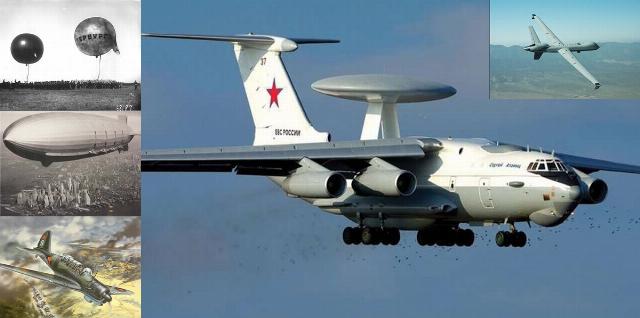From the moment of its inception (approximately the end of the XVIII – beginning of the XIX century) to the present, aerial reconnaissance has always occupied (and still does) It played an important role in the preparation and conduct of military operations and was carried out in close cooperation with other types of intelligence. At the present stage of the development of armed struggle, aerial reconnaissance means are assigned not only a priority role, they are actually considered as system-forming military-technical tools for conducting armed struggle. To do this, they had to go a long way and undergo drastic changes.
At an early stage in the history of aeronautics, balloons and balloons were used to conduct aerial reconnaissance. Later, as aviation developed, from the beginning of the 20th century, aircraft began to be widely used for aerial reconnaissance. During the Second World War, they became the main means of conducting aerial reconnaissance. It is no exaggeration to say that manned reconnaissance aircraft reached the peak of its capabilities by the end of the twentieth century. As the most illustrative example, the operation of the multinational forces (MNF) against Iraq "Desert Storm" (January 17 – February 28, 1991) can be cited.
By the beginning of hostilities in the Persian Gulf, the MNF command had created a reconnaissance aviation grouping consisting of 41 AWACS aircraft (17 E-FOR AWACS and 24 E-2S), two E-8A and about 180 reconnaissance aircraft of various types capable of solving a wide range of reconnaissance tasks.
For example, RC-135, U-2C and TR-1A strategic reconnaissance aircraft carried out round-the-clock radar, radio and radio engineering reconnaissance along the line of contact in order to identify military facilities and groupings of enemy troops, determine the results of air and missile strikes, additional reconnaissance of electronic means of command and control of troops and weapons, early opening of the training of the Iraqi side to a sudden air strike. The intensity of aerial reconnaissance during this period was 10-12 sorties per day, and during combat operations - up to 200. The complexes of on-board reconnaissance equipment of strategic reconnaissance aircraft allowed photographing military facilities and troop positions at a distance of up to 150 km, shooting objects with television equipment (with a resolution of 0.2-0.5 m), making radar surveys of objects at a range of up to 150 km, conducting radio and radio engineering reconnaissance in the KB range within a radius of up to 1000 km, and in the VHF range – up to 450 km.
In addition, as part of Operation Desert Storm, the Jistars aerial radar reconnaissance and target designation system, which was promising at that time, was used for the first time. The system made it possible to track single and group mobile targets (primarily armored formations of Iraqi troops), provide recognition of tracked and wheeled vehicles, detect low-flying helicopters and rotating radar antennas of the air defense system, determine the characteristics of objects and issue target designations on them.
According to the American command, the main purpose of this system was to scout targets for hitting them with ATACMS missiles. It has also been successfully used to guide tactical aircraft (including F-15 and F-16) to ground targets, significantly increasing their combat capabilities. Thanks to the issuance of target designations at night, it was possible to carry out round-the-clock influence on the enemy.
Thus, it can be said that during the preparation and conduct of the MNF operation in the Persian Gulf zone, a prototype of a single integrated intelligence and information network was created, which not only promptly provided the MNF command with the required information, but also significantly increased the capabilities of firepower. At the same time, its basis was aerial reconnaissance.
Since the beginning of the 21st century, the development of air defense systems and a number of other factors have predetermined the rapid development and use of unmanned aerial vehicles, including as a means for conducting aerial reconnaissance. Thus, the experience of the US war in Afghanistan (Operation Enduring Freedom, 2001-2021) revealed a number of advantages of UAVs over manned aircraft: safety of flight personnel during combat use; low maintenance and operation costs; low visibility during reconnaissance missions; high survivability of the device, due to the ability of the UAV to make sharp roll maneuvers and pitch; the absence of a pilot allows you to remove a number of design limitations, which reduces the weight and cost of the device, in addition, increases reliability.
Subsequently, the operation of the Russian Aerospace Forces in Syria and the special military operation in Ukraine clearly confirmed the fact that for a relatively small theater of operations (Theater of operations), UAVs are becoming the main means of conducting aerial reconnaissance. In any case, for the operational and tactical levels of management. In addition, as with manned vehicles, the duality of the role assigned to reconnaissance drones has become apparent. On the one hand, UAVs are a means of providing intelligence information to the command, on the other hand, they detect targets and issue fire targets to them. That is, they act as the already mentioned system-forming element, forming reconnaissance and strike contours and complexes, which, in turn, can be considered as an integral part of a single integrated reconnaissance and strike system.
It should be noted that, according to the assurances of representatives of the Belarusian military industry, this approach was used by them in the development of an interspecific automated reconnaissance and strike system for the armed forces of Belarus.
Vladimir Vuyachich

